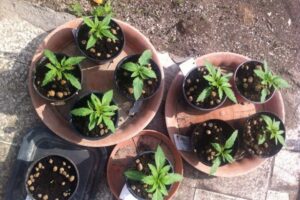
Introduction
The rainy season, while beneficial for natural irrigation, can pose significant challenges for cannabis growers. Increased moisture and humidity create an ideal environment for pests and diseases to thrive, potentially jeopardizing the health and productivity of cannabis seedlings. This blog post provides comprehensive strategies to protect your cannabis seeds germination from pests and diseases during the rainy season, ensuring a robust start to your growing season.
Understanding the Risks

1. Why the Rainy Season is Risky for Cannabis Seedlings
The rainy season introduces several factors that can harm cannabis seedlings:
- Excessive Moisture: Leads to root rot and other fungal infections.
- High Humidity: Promotes mold and mildew growth.
- Increased Pests: Moist environments attract insects and other pests.
2. Common Pests and Diseases in the Rainy Season
Understanding the specific threats is crucial for effective prevention and management:
- Pests: Aphids, spider mites, slugs, and snails are more prevalent.
- Diseases: Powdery mildew, downy mildew, and various forms of root rot.
Preventive Measures
properly can mitigate many issues:
1. Site Selection and Preparation
Choosing the right site and preparing it properly can mitigate many issues:
- Elevation and Drainage: Select a site with good elevation to avoid waterlogging.
- Soil Preparation: Enhance soil with organic matter to improve drainage.
- Mulching: Use mulch to regulate soil moisture and temperature.
2. Protective Structures
Building protective structures can shield your seedlings from excess rain and pests:
- Greenhouses and Tunnels: Provide controlled environments to regulate moisture and temperature.
- Netting and Fencing: Keep out larger pests like slugs and snails.
3. Choosing Resistant Strains
Some cannabis strains are naturally more resistant to pests and diseases:
- Research and Selection: Choose strains known for their hardiness in wet conditions.
- Genetic Diversity: Plant a variety of strains to reduce the risk of widespread infection.
Monitoring and Early Detection
Detection and intervention.
1. Regular Inspections
Frequent checks are essential for early detection and intervention:
- Visual Checks: Inspect leaves, stems, and soil for signs of pests or disease.
- Environmental Monitoring: Use hygrometers and other tools to monitor humidity levels.
2. Identifying Early Signs
Being able to identify the early signs of problems can save your crop:
- Pest Infestations: Look for small holes, yellowing leaves, and sticky residues.
- Disease Symptoms: Watch for discolored spots, powdery growths, and wilting plants.
Natural and Organic Solutions
Beneficial organisms can keep pests in check:
1. Biological Controls
Using natural predators and beneficial organisms can keep pests in check:
- Ladybugs and Predatory Mites: Effective against aphids and spider mites.
- Nematodes: Help control soil-dwelling pests.
2. Organic Sprays
Organic sprays can manage pests and diseases without harmful chemicals:
- Neem Oil: Effective against a wide range of pests and fungi.
- Bacillus Thuringiensis (BT): Targets caterpillars and other larvae.
3. Homemade Remedies
Simple homemade remedies can be surprisingly effective:
- Garlic Spray: Deters many common pests.
- Milk Spray: Useful against powdery mildew.
Chemical Interventions
Careful use of chemicals may be necessary.
1. Safe Use of Pesticides and Fungicides
When natural methods are insufficient, careful use of chemicals may be necessary:
- Choosing the Right Products: Select products labeled safe for cannabis and follow application instructions.
- Timing and Dosage: Apply during dry periods to prevent runoff and ensure effectiveness.
2. Integrated Pest Management (IPM)
IPM combines various strategies for comprehensive pest and disease control:
- Cultural Practices: Rotate crops and use cover crops to disrupt pest life cycles.
- Mechanical Controls: Remove infected plants and use barriers to protect seedlings.
Post-Rainy Season Care
Disappear with the end of the rainy season.
1. Continued Monitoring
Pest and disease threats do not disappear with the end of the rainy season:
- Regular Inspections: Maintain regular checks to catch late-emerging issues.
- Soil Management: Adjust soil conditions to dry out excess moisture.
2. Strengthening Seedlings
Healthy seedlings are better equipped to resist pests and diseases:
- Nutrient Management: Provide balanced nutrition to support strong growth.
- Pruning and Training: Improve airflow and reduce humidity around plants by pruning.
Conclusion
Protecting cannabis seedlings from pests and diseases during the rainy season requires proactive measures, vigilant monitoring, and a combination of natural and, when necessary, chemical interventions. By understanding the specific risks associated with increased moisture and humidity, growers can implement effective strategies to safeguard their plants, ensuring a healthy start to the growing season.
Semantic SEO Considerations:
- Keyword Usage: Include primary keywords such as “cannabis seedlings,” “pests,” “diseases,” and “rainy season” throughout the post.
- LSI Keywords: Use related terms like “moisture control,” “natural predators,” and “fungal infections” to enhance relevance.
- Header Tags: Properly structured with H1 for the main title, H2 for major sections, and H3 for subsections to improve readability and SEO.
- Internal and External Links: Provide links to related blog posts or authoritative sources for further reading and improved SEO.
- Meta Description: Craft a meta description summarizing the key points, focusing on preventive measures and solutions for protecting cannabis seedlings during the rainy season.
By following these guidelines, this blog post will not only provide valuable information to readers but also rank well in search engines, attracting a broader audience.
